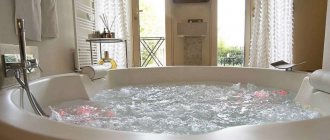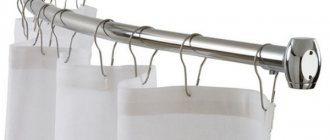There are many options for solving the issue of bathroom lighting. You can use lights built into the suspended ceiling, use wall sconces, or even use LED lighting. But the most traditional and at the same time chic version of the lighting fixture remains the central chandelier. Ultra-modern, designer or traditional and even antique - chandeliers not only provide the necessary level of illumination in the room for water treatments, but also effectively complement the interior, bringing elegance, creativity or luxury to the design of a utilitarian space.
Principles for choosing a luminaire
Unlike chandeliers and sconces, it is necessary to choose spotlights for the bathroom based on design features and characteristics. Fixed (non-rotating) are attached to the ceiling or in plasterboard structures stably and provide a strictly directed flow of light. Rotating ones allow you to change the direction of the light at will, since this type has a rotating bell.
It is important to study the instructions and pay attention to the markings. The first number shows the level of protection against penetration of various solid particles, the second – the protective degree from moisture. For example, bathroom fixtures marked IP55 are not afraid of moisture.
Various versions of these types are presented by companies from Germany, Italy, Spain or the UK: halogen and standard. Russian manufacturers create models only with traditional incandescent lamps.
The design of both domestic and imported lamps is extensive, while models made in Russia will be much cheaper.
Kinds
Lamp manufacturers divide their products into two types:
- Modern products.
- Classic products.
Modern sconces include the bulk of lamps, varying in shape, color, size and design. The group is quite large. And a certain type is selected according to your interior.
Classic sconces are distinguished by stylized shades in the style of past centuries. Lamps in the form of melted candles, torches, metal sconces, decorated with artistic forging - it is impossible to confuse classic lamps with anything else.
Which lamp is more economical
When choosing, you need to focus not only on the price and model, but also on the type of lamp, since the financial costs of operation depend on this.
Where should lighting fixtures be located?
In the bathroom you can implement one of three options:
- Placement above the mirror. In most cases, this location is chosen. It is most convenient to install horizontal lamps that provide directional illumination. It is important to adjust the lighting fixture, pointing it towards the work area. But with this installation option, the light is directed from above, so facial skin defects in the mirror will be pronounced.
- On the side. When placing devices on both sides of the mirror, it is possible to give the room a complete look. If you install only one lamp, the light will spread unevenly, with shadows, therefore a symmetrical arrangement of devices is required.
- Against. Sconces installed on the side opposite the mirror allow you to visually make the room larger and brighter. But there is one drawback - the appearance of glare, which prevents the performance of daily procedures in the most comfortable conditions.
LED bulbs
A modern option that provides significant advantages:
- Good degree of lighting.
- Long-term performance capabilities.
- Economical power consumption.
There are some disadvantages:
- Installation is carried out via a transformer.
- High price (about 5 times more than other lamp options).
But LED bath lights pay for themselves quite quickly due to energy savings. They are universal because they have different types of cartridges: G5, G9, G14, G4 and standard E27.
Safe Operation
At the renovation stage, it is very important to carefully consider a lighting scheme that will protect you and your family while using the sconce.
Modern lighting choices in the bathroom
Remember, electricity and high humidity in the bathroom are an explosive mixture. Therefore, in order to eliminate any risks, the placement of lamps and the supply of electricity to them is carried out at the stage of wall finishing.
The main requirements for installing sconces in the bathroom:
- avoid contact with water;
- the sconce design must be sealed and without any damage;
- you cannot mount the sconce directly above the bathtub: from hot glass and water, the lamp will simply explode;
- open wiring leading to the lamp is taboo; if you do the installation yourself, use a closed type of cable routing;
- do not use tees and extensions in the bathroom;
- sockets should be located at the maximum distance from the water source;
- buy sockets with a moisture-proof cover;
- The electrical network in the bathroom must be grounded.
Take the installation of lighting in the bathroom extremely seriously and responsibly, because we are talking about the safety of your family.
Fulfill all the requirements according to our recommendations and then you can use your new sconces with peace of mind. Otherwise, use the services of a specialist who will give you guarantees for the safe operation of the product.
Safety of use
Lamps with lamps of about 12-24 watts are considered safe for household needs; even if shorted, they will not cause much harm. There are certain restrictions for suspended ceilings.
- For fabric no higher than 60 watts
- And no more than 40 watts for PVC incandescent lamps.
- Halogen permissible 25 and 20 watts, respectively.
In addition, it is advisable that the installation be carried out by experienced electricians.
Calculation of the required number of lamps
After choosing the type of lamp, you need to decide which lamps on the ceiling in the bathroom will be most optimal. Then it is important to correctly calculate the number of lighting elements. For this, the following is taken into account:
- Presence or absence of windows.
- Room area.
- Ceiling height.
- The need for zoning.
- Purpose of the premises. For bathrooms and living rooms, lamps differ in their characteristics.
For example. With a standard height of 2.80 m, one lamp is needed for every 1.5 - 2 meters. Therefore, for a room of 10 m², 5 - 6 pieces are installed. But it all depends on the presence of a chandelier and other lighting sources. At the same time, lamps on the ceiling in the bathroom can only be located in the washbasin area, and not above the shower stall or the bath itself.
Chandelier: the most unexpected element in the bathroom interior
The last decade has seen an increase in interest in small bathroom design. At the same time, an increasing number of homeowners prefer to see their interiors stylish and sophisticated, while the fashion for minimalism is becoming a thing of the past.
The way of life itself has changed, and people began to feel an urgent need to have a special relaxing space, reminiscent of a spa, for example. Luxurious, grandiose and innovative - these are the bathrooms that are trending today.
Glass showers and free-standing bathtubs have become mandatory components of their interiors. But shouldn't a sparkling chandelier be the key element of a sophisticated look?
Of course, the bathroom is not the place where we expect to see such a prominent and attention-grabbing item. But this ability to generate the effect of surprise is what makes a chandelier an ideal addition to the interior.
Of course, it is not cheap, and it is somewhat more difficult to install than standard lamps in shades, but the result promises to be amazing! Appreciate the magnificence of the images presented in our selection and choose your ideal chandelier today.
Magnificent cascade
The glittering world of chandeliers is ruled by these captivating cascading designs that hang thrillingly overhead. Models from this series have become real hits, and it is quite possible that your bathroom interior is missing something similar.
But aesthetics are not the only thing you should think about when deciding to buy a chandelier. Experts believe that such lamps should be placed at a height of at least 2.5 meters from the bath itself and preferably away from it. Of course, with good ventilation and constant monitoring of humidity levels, these conditions can be changed.
In fact, many designers prefer to install cascading chandeliers above the bathtub. If you also intend to go this route, first make sure that your ceilings are high enough so that you do not have to hit the pendants with your head. For those who have not yet decided on the choice of Floating Bubble Light.
Time tested
Looking for something less extravagant and more traditional? Elegant glass chandeliers are one of those things that never go out of style. They invariably bring elegance and vintage chic to the interior - be it the bathroom or any other space. Classic chandeliers are more compact, so they are ideal for small spaces that are too cramped for cascading models.
Classic glass chandeliers come in different shapes and colors. You can choose a model that goes well with the sconce, which is usually installed near the mirror.
Stylish challenge
A chandelier should not, like utilitarian fixtures, be a secondary design element. Let it be truly noticeable and set the tone for the interior.
No matter what style your bathroom is in - rustic or industrial, Asian or Victorian - there is always a chandelier that will truly enhance it and not just fade into the background. And by the way, glass is not the only material possible in this case. As the examples below show, author’s options also have a right to exist.
The images we have proposed may seem excessive at first glance. But isn't it time to free yourself from stereotypes and try to make your wildest fantasies come true?











